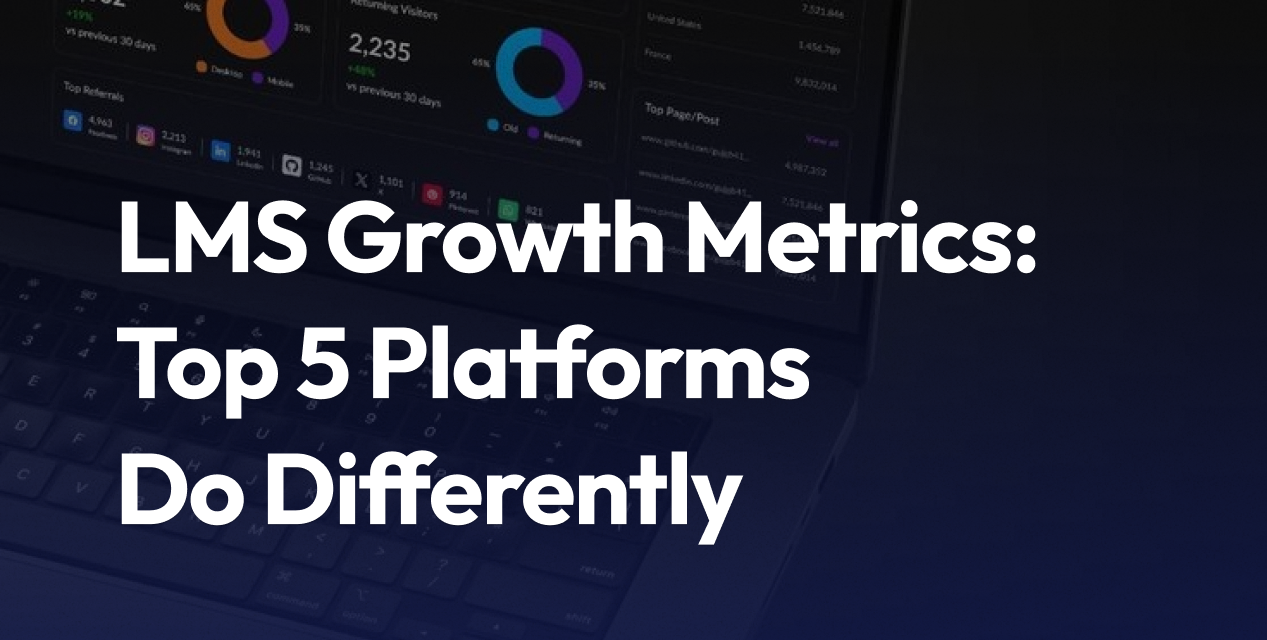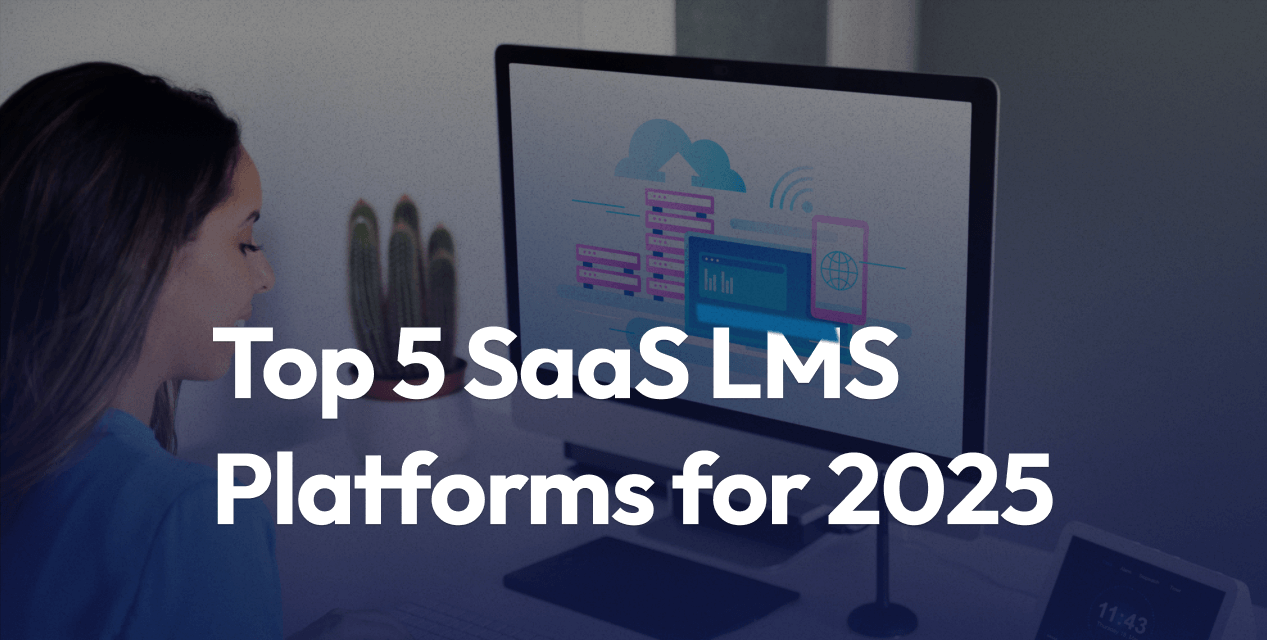
LMS Growth Metrics: What the Top 5 Platforms Do Differently
- The core LMS growth metrics to track: activation, engagement, completion, revenue, and efficiency
- What the top 5 platforms do differently: AI-driven personalization, faster course build, social learning, simple UX, and compliance value
- Simple benchmarks: activation 40–60 percent, completion 45–70 percent, weekly active 25–40 percent, time-to-first-course under 24 hours
- A 90-day plan to instrument, improve, and automate growth metrics
- Common pitfalls: vanity dashboards, scattered data, weak onboarding, no lifecycle messaging
- How to act today: define your metrics, wire your events, and ship one automation this week
Most LMS teams want the same three wins: more active learners, higher completions, and steady course revenue. The twist is doing it without drowning your admins in manual work. This guide shows how to pick the right numbers, learn from the top platforms, and install a simple growth loop. It is built for L&D leaders, RevOps, product managers, and LMS admins who need results, not buzzwords.
Recommended reading + Beginning CTA Automate routine work and focus on learning. Recommended: a practical guide on LMS automation and analytics for clean tracking and faster reporting. We will invite you to book a consult later in this post.
What LMS Growth Metrics Matter in 2025-2026
You do not need 50 metrics. Track five that connect to adoption, engagement, revenue, and efficiency. Keep formulas plain and useful.
- Activation rate (adoption): percent of new sign-ups who complete their first lesson within 7 days Formula: first-lesson-completers in 7 days divided by new sign-ups Why it matters: shows how well your onboarding pulls learners into action. Benchmark: 40–60 percent is common with email nudges and in-product checklists.
- Weekly active learners (engagement): unique learners who take at least one learning action in a week Formula: weekly unique learners with lesson view, quiz, or assignment Why it matters: the pulse of your LMS. If this is flat, revenue stalls. Benchmark: 25–40 percent of monthly active learners is healthy.
- Course completion rate (quality and outcomes): percent of enrolled learners who finish a course Formula: course completions divided by course enrollments Why it matters: strong signal for content fit and course design. Benchmark: 45–70 percent for structured compliance or short skills. Longer courses run lower.
- Time to first course published (speed to value for admins): days from admin account creation to first course live Formula: course first published date minus admin signup date Why it matters: shorter setup time, faster catalog growth. Benchmark: under 7 days for teams using templates and AI assist. Top teams hit under 24 hours.
- Revenue per learner (revenue): average revenue from each active learner Formula: course sales or internal cost allocation divided by active learners Why it matters: proves the model. Benchmark: varies by model. For paid catalogs, 15–50 dollars per month per active learner is common.
- Cost per completion (efficiency): total delivery cost divided by number of completions Formula: content cost plus platform cost plus support time, all divided by completions Why it matters: lets you scale without surprise spend. Benchmark: AI and automation can cut costs 20–30 percent, with 25–60 percent higher retention reported in eLearning settings.
Context that supports action: mobile use keeps rising, and AI personalization is now standard across leaders. This points to strong gains when you simplify onboarding, personalize content, and automate nudges.
What the Top 5 LMS Platforms Do Differently to Grow
The leaders push specific tactics that move growth metrics. You can copy the ideas without switching platforms.
- Docebo: AI-driven content routing and nudges The tactic: adaptive recommendations and automated email or in-app prompts. Moves: weekly active learners and completion rate. Try this: tag your courses by role and skill, then send two automated lesson suggestions per week based on last activity. Start with a simple rule, like “If inactive for 7 days and enrolled in Project A, send Lesson 2 recap.”
- TalentLMS: simple UX and quick setup The tactic: fewer clicks to enroll, clean navigation, and instant sandbox creation. Moves: activation rate and time to first course published. Try this: create a 3-step admin checklist with a sample course template and a prebuilt quiz. Set an auto email that fires 24 hours after admin signup with the template link. Aim to get a first course live within a day.
- LearnWorlds: creator-first course build and commerce The tactic: fast course authoring, video tools, and built-in checkout. Moves: catalog growth, revenue per learner. Try this: pick your top three topics, clone a course skeleton, and add one interactive video per course. Set a two-tier price with a free preview lesson. Shorten path to purchase to two steps.
- Fuse Universal: social learning and UGC The tactic: comments, quick posts, and short video responses from peers. Moves: weekly active learners and completion rate. Try this: add a “practice wall” at the end of a course. Ask learners to post a 30-second tip or question. Award a badge for the first post and highlight two posts in a weekly digest.
- Illumeo: compliance focus with credits and integrations The tactic: tie learning to professional credits and HRIS integrations. Moves: adoption and completion rate in regulated roles. Try this: list credit-bearing courses, show hours earned on the dashboard, and sync completion data to HR. Send a quarterly compliance status email with hours remaining.
Want to compare platforms for custom learning paths and personalization? See this breakdown of LMS Light versus Canvas for custom learning paths. Use it to stress-test your path rules and authoring flow.
90-Day Plan to Track and Improve Your LMS Growth Metrics
Phase 1, Weeks 1–4: Instrument and baseline
- Define events: signup, first lesson completed, weekly active, completion, publish course, purchase.
- Add plain-language naming for segments: new learners, admins, managers, buyers.
- Build one dashboard with the five metrics above.
- Baseline for last 8 weeks, then track weekly. Outputs: a shared metric glossary, one dashboard, and a baseline report.
Phase 2, Weeks 5–8: Fix activation and completion
- Onboarding: add an in-app checklist for new learners with three steps, “Start first lesson,” “Join discussion,” “Finish first quiz.”
- Lifecycle messages: two emails and one in-app prompt per week, tied to last activity and course stage.
- Course polish: cut lesson length to 5–7 minutes, add a short recap quiz, and show progress at the top of each course.
- Social cue: at the end of each module, invite a one-sentence reflection or one tip. Outputs: a new learner flow, updated courses with progress cues, and a simple message schedule.
Phase 3, Weeks 9–12: Automate and scale what works
- Admin speed: publish with templates, prebuilt quiz banks, and a “copy course” workflow.
- Revenue path: for paid catalogs, add a free preview and a two-step checkout. For internal training, show a value dashboard with completions, hours saved, and compliance status.
- Personalization: tag courses by role and skill. Send weekly recommendations based on last course taken or skill gap.
- Efficiency: auto-enroll by role, auto-grade objective quizzes, and schedule weekly reports to Slack or email.
Quick success checklist
- Metrics are defined, visible, and trend weekly.
- Activation is up 10–20 percent.
- Completion rate rises 10 points.
- Time to first course published drops under 7 days.
- Admin hours per 100 learners drop 20 percent.
FAQ: LMS Growth Metrics
What is a good activation rate for an LMS? Aim for 40–60 percent of new sign-ups completing a first lesson within 7 days. If you add a checklist and two nudges, you can hit the high end.
How do I raise course completion? Shorten lessons, add micro-quizzes, and show progress early and often. Use two gentle prompts, one in-app and one by email, during gaps in activity.
How often should I check metrics? Weekly. A short weekly view catches drops fast. Keep a monthly view to spot seasonality and trend lines.
Which metric predicts revenue best? Weekly active learners and completion rate together. If both rise, more learners move to purchase or finish compliance on time, which supports renewals.
What is the simplest way to cut admin time? Use templates, auto-enroll by role, and auto-grade quizzes where possible. Schedule reports so no one has to pull the same CSV twice.
How many lifecycle messages is too many? Start with two per week per learner, tied to their stage. If opt-outs rise or open rates fall, cut back or improve relevance.
Does mobile matter for growth? Yes. Mobile learning time keeps rising. Make courses short, video friendly, and easy to resume on a phone.
What if my LMS cannot personalize content? Use simple rules. Tag courses by role and last activity. Send a weekly suggestion that matches the learner’s job and recent progress.
Conclusion
This growth playbook keeps focus on four big levers: activation, engagement, quality, and efficiency. Copy proven moves from leaders. Take AI-driven nudges from Docebo, faster build from LearnWorlds, social loops from Fuse Universal, simple UX and eCommerce from TalentLMS, and credit plus integration from Illumeo. Pair those ideas with the five metrics above, then run the 90-day plan to measure gains. The aim is simple, more learners active, more completions, steady revenue, and fewer admin hours. Start with one automation this week and track the lift in your activation rate next Monday.
We’ll map quick-win automations for enrollments, grading, and reporting in your LMS. Button:
Automate routine work and focus on learning. Use the plan above, then measure activation, weekly active, completion, revenue per learner, and cost per completion. You will see early gains within two sprints.
Looking for expert help standing this up end-to-end? Explore Consulting services for efficient LMS growth and analytics.


